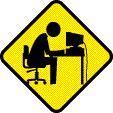 Recently I read a very pertinent and apropos blog which I have taken the liberty of plagiarizing –at least, to some extent.
Recently I read a very pertinent and apropos blog which I have taken the liberty of plagiarizing –at least, to some extent. If you want your e-mail ignored do these things:
So, how can you contribute towards a more calm and courteous communication between us all?
State, as explicitly and simply as you can what your message is about in the "Subject" line. That's that line with the label 'Subject' up in the 'Header' section of the email. Messages with vague subjects such 'Hi, Hello, How are you?' and, even worse, left glaringly blank, invite instant deletion by those of us who do not get paid on word counts of emails read each morning.
Remember that many of us are savvy enough to have set our spam deletion rules to filter emails that use all capital letters, an excess of exclamation points, and words typically seen in spam. I'd give examples, but my spam filter would trap them and refuse to send the email. I don't use these kinds of expletives myself, I do not treat my recipients to samples of what used to be called the 'gutter press' so please don't do it to me.
Messages that are one long paragraph with complicated details (rather like this one) will often not get read either. Do yourself and your longsuffering recipient a favour and break up your message into three or four small paragraphs. Unless you are sending a draft copy of the annual 'Address to the Nation' a reasonable limit, it seems to me, is three or four paragraphs. After that I think it likely that most of us will start dozing. If your email has to be lengthy consider providing a one or two sentence overview. Even a quick bulleted list of topics to be covered introduced with an explanatory, "I have a complicated issue, which will take a bit of explaining. Here is the gist and below is the lengthier explanation." Or, "I need help with xyz. If you have time to help, I've provided details below." If you need answers to a series of questions and/or you need to make several points, why not number them? This will make replying easier as the answers can be numbered accordingly thus saving the need to restate each issue or question.
If you want to share a link, please don't just stick the URL in the e-mail, particularly if it's a long one as is often the case. Most email utilities, such as Outlook and others will allow you to use html and code it into the source so that you can create a clickable link and all the gobbledygook is hidden. Another courteous trick (read technique) is to use TinyUrl. This will allow you to enter the long URL and convert it into a shorter version. It's quite free and you can add a toolbar shortcut for frequent use.
Now for photos: This can be a real issue, especially for those longsuffering souls among us who still labour with dial-up and other slow connections. If you need to share a bunch of photos don't just attach them by the dozen. If there are more than three or four courtesy demands they be zipped or posted to a site such as Flicr (the link to my public photos on Flickr). You can then email the link and the burden of a huge download is not laid uninvited upon your recipient. An excellent free compression utility is 7-Zip.
More on Photos: Further, when sending images please reduce them in size. A dozen 4-megabyte photos of your last picnic will not win your friends and allow you to influence people towards your latest favourite thing! Learn to use an image resize for reducing the size of images for exactly this purpose. Microsoft has a free one for XP as part of its Power Toys collection. There's one for Vista too, if you're afflicted with that particular OS.
Videos: While I'm on topic let me discuss sending 10-megabyte videos of birds using tools. Now vides are fun, but attaching a video in e-mail is so passé. If you look I'll bet you'll find it on YouTube. Here's a way to send big files when needs must. There are several places on the web where you can upload large files for free as well as paid services. Try LargeFilesASAP, or Huddle. Provided it's not something super private these are good options to crashing your friend's machine!
Turn of Your Antivirus Blurb: Most people who have any sense today do have their own Antivirus programmes running and scanning their incoming and outgoing emails. This means they do not need to see your AV program's blurb at the bottom of your e-mail telling them it has scanned the email before sending. Take a moment to check out your AV programmes Options and just turn it off please. Thank you.
OK. That's about it, for me. I think I've made my contribution towards world peace and goodwill with this little blurb. My appreciation to my muse -you will recognize some of it, but not a whole heap I'm thinking.

Happy emailing my fellow netizens.




